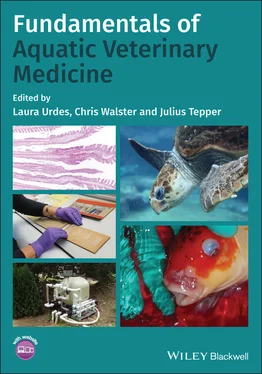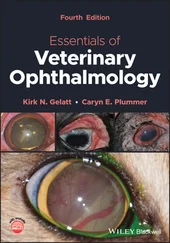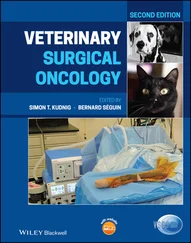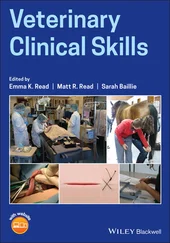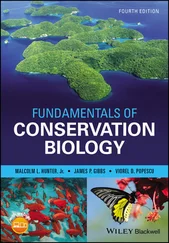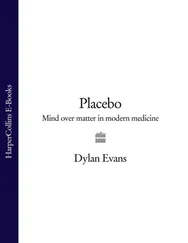Fundamentals of Aquatic Veterinary Medicine
Здесь есть возможность читать онлайн «Fundamentals of Aquatic Veterinary Medicine» — ознакомительный отрывок электронной книги совершенно бесплатно, а после прочтения отрывка купить полную версию. В некоторых случаях можно слушать аудио, скачать через торрент в формате fb2 и присутствует краткое содержание. Жанр: unrecognised, на английском языке. Описание произведения, (предисловие) а так же отзывы посетителей доступны на портале библиотеки ЛибКат.
- Название:Fundamentals of Aquatic Veterinary Medicine
- Автор:
- Жанр:
- Год:неизвестен
- ISBN:нет данных
- Рейтинг книги:4 / 5. Голосов: 1
-
Избранное:Добавить в избранное
- Отзывы:
-
Ваша оценка:
- 80
- 1
- 2
- 3
- 4
- 5
Fundamentals of Aquatic Veterinary Medicine: краткое содержание, описание и аннотация
Предлагаем к чтению аннотацию, описание, краткое содержание или предисловие (зависит от того, что написал сам автор книги «Fundamentals of Aquatic Veterinary Medicine»). Если вы не нашли необходимую информацию о книге — напишите в комментариях, мы постараемся отыскать её.
Covers the competencies necessary to assure the highest quality of aquatic veterinary services Fundamentals of Aquatic Veterinary Medicine
Fundamentals of Aquatic Veterinary Medicine — читать онлайн ознакомительный отрывок
Ниже представлен текст книги, разбитый по страницам. Система сохранения места последней прочитанной страницы, позволяет с удобством читать онлайн бесплатно книгу «Fundamentals of Aquatic Veterinary Medicine», без необходимости каждый раз заново искать на чём Вы остановились. Поставьте закладку, и сможете в любой момент перейти на страницу, на которой закончили чтение.
Интервал:
Закладка:
1.3.2.4 Dissolved Oxygen
Dissolved oxygen monitoring is critical in aquaculture. Temperature, salinity and elevation affect dissolved oxygen. As these three factors increase, dissolved oxygen at saturation decreases. For example, the cold temperature of the Antarctic results in higher dissolved oxygen concentrations compared with warmer tropical waters. Freshwater at sea level holds 9.2 ppm at 20°C and 7.6 ppm at 30°C. Fish become more active and increase their metabolic oxygen needs as temperature increases. As temperature rises, fish also need more dissolved oxygen to grow muscle tissue. Minimum tolerable dissolved oxygen levels increase with a rise in temperature.
In general, most fish species will grow and thrive within a dissolved oxygen range of 5–12 mg/l (parts per million). However, if levels drop below 4 mg/l they may stop feeding, become stressed and begin to die. Dissolved oxygen ranges for cultured fish are as follows:
0–2 ppm – small fish may survive a short exposure, but lethal if exposure is prolonged. This range is lethal to larger fish.
2–5 ppm – most fish survive, but growth is slower if prolonged; may be stressful; aeration devices are often used below 3 ppm.
5 ppm to saturation – the desirable range for all.
With rainbow trout, the minimum lethal limit is 1.6 ppm at lower temperatures and 2.5 ppm at higher temperatures.
Oxygen and pH are best measured in situ (with probes) or as soon as possible after collection (preferably before leaving the site) as, in most situations, levels will change during storage and transport.
Biological oxygen demand is a measure of the oxygen used by all organisms in an aquasystem.
1.3.2.5 Carbon Dioxide
Carbon dioxide (CO 2) is consumed during photosynthesis by plants and expired during respiration by animals, plants (at night) and bacteria in an aquasystem. When added to pond water by respiration or diffusion, it forms a weak acid (carbonic acid), which lowers the pH. Dissolved oxygen and pH cycles follow the same daily peaks and troughs. Carbon dioxide levels of below 10 mg/l are thought to be well tolerated by fish. While levels greater than 20 ppm often harm fish, especially if dissolved oxygen levels are low, sensitivity to CO 2varies between species. The level of CO 2in source water varies greatly, and is further affected by the respiratory and photosynthetic activity of animals and plants, and the level of decomposition of organic material in that water (a very significant contributor to CO 2levels in some nutrient‐rich waters). CO 2can build up to significantly high levels in systems with large numbers of animals and relatively slow water turnover.
The effect of increased CO 2in water is to reduce the rate at which CO 2from the animal's own metabolism can be released from the blood through the gills. As a result, CO 2in the blood also increases (known as hypercapnia), resulting in a drop in the blood pH and acidosis. At the same time, the oxygen‐carrying ability of the hemoglobin in the blood is reduced. The animal can counteract the effect by balancing the acidosis with an exchange of ions, such as increasing the uptake of bicarbonate and losing hydrogen and phosphate ions and little harm is done. In the long term, this balancing act can have a more profound effect on the health of the animal. Carbon dioxide causes problems in recirculating aquaculture systems without aeration or degassing.
1.3.2.6 Nitrogen
The nitrogen (N 2) biogeochemistry of aquaculture ponds is dominated by biological transformations of nitrogen added to ponds in the form of inorganic or organic fertilizers and formulated feeds. Nitrogen application in excess of pond assimilatory capacity can lead to the deterioration of water quality through the accumulation of nitrogenous compounds (e.g., ammonia and nitrite) toxic to the fauna. Principal sources of nitrogen include animal excretion and sediment flux derived from the mineralization of organic matter and molecular diffusion from reduced sediment, although cyanobacterial nitrogen fixation and atmospheric deposition are occasionally important.
1.3.2.7 Hydrogen Sulfide
Hydrogen Sulfide (H 2S) is a poisonous gas with a “rotten egg” smell, produced by anaerobic decomposition of organics. Sulfur is an essential element for plants, animals and bacteria. H 2S is present in natural waters and in aquaculture systems, mainly as the sulfate ion. Sulfide can occur in water because it is a metabolite of Desulfovibrio species and certain other bacteria found in anaerobic zones, usually in sediment. These bacteria use oxygen from sulfate as an alternative to molecular oxygen in respiration. There are three forms of sulfide (H 2S, HS –and S 2 –), and they exist in a pH and temperature‐dependent equilibrium. As pH increases, the proportion of H 2S declines, and that of HS –rises until the two forms have roughly equal proportions at pH 7. At greater pH, HS –is the dominant form, and there is no S 2 –until the pH is above 11. Hydrogen sulfide is toxic to aquatic animals because it interferes with reoxidation of cytochrome a3 in respiration. This effect is caused almost entirely by H 2S, while HS –is essentially non‐toxic. Even if it is toxic, S 2 –is not an issue, because it does not occur at pH values found in aquaculture systems.
1.3.2.8 Chlorine
Chlorine is harmful/toxic to fish at values greater than 0.03 ppm. Tap water may range from 4.0 to 8.0 ppm. Sodium thiosulfate can be used to neutralize the chlorine. Chlorine may be used to disinfect equipment, tanks, countertops, and nets at 10 ppm for 24 hours or 200 ppm for 30–60 minutes. Effectiveness is reduced by organic material such as mud, slime and plant material. Sodium hypochlorite is available at concentrations of 15%, 50%, or 65% active.
1.3.2.9 Alkalinity
Alkalinity is the ability of the water to accept hydrogen ions and neutralize them and offers a buffering system to reduce pH swings. It is measured by the amount of acid (hydrogen ion) that water can absorb (buffer) before achieving a designated pH. Total alkalinity is expressed as milligrams per liter or parts per million calcium carbonate (mg/l or ppm CaCO 3). It consists of negatively charged bases – carbonates, bicarbonates, and hydroxides. Alkalinity is expressed in equivalent concentrations of calcium carbonate.
Carbonates and bicarbonates are sources of carbon for plants, which is used in photosynthesis to make carbohydrates. Carbonates and bicarbonates are the most common and most important components of alkalinity. A desirable range of total alkalinity for fish culture is CaCO 375–200 mg/l. Carbonate–bicarbonate alkalinity (and hardness) in surface and well waters is produced primarily through the interactions of CO 2, water and limestone. Rainwater is acidic because of exposure to atmospheric carbon dioxide and sulfuric acid (H 2SO 4).
1.3.2.10 Hardness
Hardness refers to the concentration of divalent cations (calcium, magnesium, and sodium). Water hardness is important to fish culture and is a commonly reported aspect of water quality. It is also expressed as the calcium carbonate equivalent concentration. The same carbonate rocks responsible for most of the alkalinity are the main sources of calcium and magnesium cations for hardness. Hardness may be an index of potential pond productivity. The minimum hardness for fish is 20 ppm and optimum hardness is around 100 ppm.
Hardness is traditionally measured by chemical titration. The hardness of a water sample is reported in milligrams per liter as calcium carbonate (mg/l CaCO 3). Calcium carbonate hardness is a general term which indicates the total quantity of divalent salts present and does not specifically identify whether calcium, magnesium and/or some other divalent salt is causing water hardness. If limestone is responsible for both hardness and alkalinity, the concentrations will be similar, if not identical. However, where sodium bicarbonate (NaHCO 3) is responsible for alkalinity, it is possible to have low hardness and high alkalinity.
Читать дальшеИнтервал:
Закладка:
Похожие книги на «Fundamentals of Aquatic Veterinary Medicine»
Представляем Вашему вниманию похожие книги на «Fundamentals of Aquatic Veterinary Medicine» списком для выбора. Мы отобрали схожую по названию и смыслу литературу в надежде предоставить читателям больше вариантов отыскать новые, интересные, ещё непрочитанные произведения.
Обсуждение, отзывы о книге «Fundamentals of Aquatic Veterinary Medicine» и просто собственные мнения читателей. Оставьте ваши комментарии, напишите, что Вы думаете о произведении, его смысле или главных героях. Укажите что конкретно понравилось, а что нет, и почему Вы так считаете.
